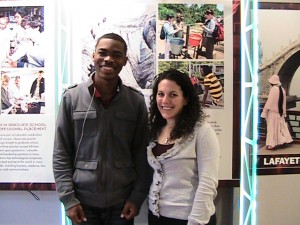Heterogeneous Network Formation via Polymerization Induced Phase Separation: An approach to low shrinkage dental restorative materials
Concerning the talk:
Caroline Szczepanski’s research looks specifically at the use of free radical, photo-polymerization to improve the physical and mechanical properties of dental restorative materials. Using photo-initiated polymerization allows more control over the polymerization process in terms of time and place of execution. In addition to spatial and temporal control, photo-polymerization also seems to solve the occurrence of volumetric shrinkage and stress increase upon curing. The explanation of this ability of photo-polymerization is speculated to lie within the fact that the polymerization process results in a heterogeneous network which phase separates. Caroline and her laboratory are looking at further characterizing and understand the physical properties of the materials produced from Polymerization Induced Phase Separation (PIPS).
Free radical, photo-polymerizations are an attractive option for materials utilized in coatings, stereo-lithography and biological applications. Utilizing photo-initiation offers enhanced spatial and temporal control of the polymerization when compared to thermally initiated systems. Additionally, the ability to cure at ambient conditions makes photo-polymerizations suitable for the development of dental restorative materials. Dimethacrylate based resins have been researched and utilized as photo-curable dental materials because they can form glassy, densely cross-linked networks with good biocompatibility upon photo-polymerization. However, they do not avoid the inherent shrinkage and associated stress that occur during cure, leading to internal and interfacial defects. For this reason, research has focused on the development of heterogeneous networks with interfacial structure that can compensate for some or all of this shrinkage.
Polymerization Induced Phase Separation is an elegant approach to develop heterogeneous networks because it allows tuning of the final phase structure based on the kinetics and thermodynamics of the polymerization reaction. Networks formed via PIPS can compensate for volumetric shrinkage and stress through internal volume expansion resulting in shrinkage and stress reduction. Caroline’s lab proposes that this expansion is a result of covalent linkage or physical entanglements between phases polymerizing at different rates. Previous work investigating shrinkage reduction through PIPS has often resorted to using initiation mechanisms and monomer formulations inappropriate for biological applications.
Caroline presents an approach to PIPS using purely photo-initiated, biologically compatible materials. Non-reactive prepolymers of varying side chain length, poly-(methyl, ethyl and butyl) methacrylates (PMMA, PEMA, PBMA) were added to a bulk homopolymer matrix of tri-ethylene glycol dimethacrylate (TEGDMA). These materials are stable and homogeneous at room temperature in the monomer form. Upon photo-irradiation, the majority of materials underwent PIPS, resulting in two-phase structure. The phase separation process was characterized by measuring dynamic changes in sample turbidity. Currently, the phase structure development is being studied using confocal microscopy to further understand the physical mechanism of volumetric shrinkage and stress reduction via PIPS.
Concerning the speaker:
Caroline Szczepanski graduated from Lafayette College in Easton, PA in 2009 with a B.S. in Chemical Engineering. In August 2009 she enrolled in the PhD program in Chemical & Biological Engineering at Colorado University -Boulder and in January 2010 began her thesis project in Dr. Stansbury’s laboratory. She visited Lafayette College in March 2013 to share the development of her research and her experiences in graduate school.

Leave a Reply